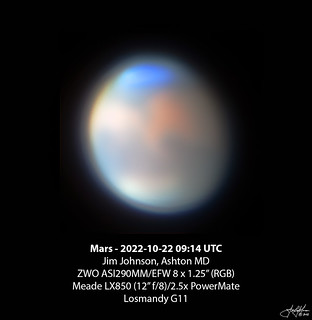Last night would have been a very good night for DSO imaging, but because Thursday’s Astrospheric was forecasting Excellent seeing for several hours on Friday evening into Saturday morning.. I do not recall ever seeing a forecast for better than Above Average that good before.
Because of that forecast, I set up for planetary instead of DSO imaging on Thursday afternoon. As Thursday and Friday passed, the number of hours that the seeing would be excellent diminished, and eventually just went away. Above average seeing was the best forecast that I was left with, and that did not begin until the 0400 hour.
I used the same setup (ASI290MM/Meade/G11), polar alignment and collimation that I used on for the 2022-10-20/21 session. This meant that I powered up at CWD and slewed to a target and started shooting after making minor adjustments to the Firecapture settings.
I worked at the scope three separate times to work each planet separately. My plan for Saturn and Jupiter was to shoot them at a convenient time after each had cleared the trees. My plan for Mars was a little more complex as I wanted to wait for the best opportunity for this target as it gained altitude and the seeing improved.
Saturn was the first target, which I worked on from 1915 to 1940. The temperature was 47 degrees, there was no surface breeze, and there was no dew on the metal table. Seeing on the display seemed consistent with the forecasted average seeing. I shot a 30-frame run of 1.3s (not ms) exposures, which is highly over exposed to bring out five of Saturn’s satellites. My main capture on Saturn consisted of five 60s RGB runs.
Jupiter was next and I was outside from 2110 to 2150, at which time the temperature was 42 degrees. There was no surface breeze, and there was no dew on the metal table. Seeing on the display seemed to be consistent with the forecasted average seeing. I shot ten 30s RGB runs.
I elected to wait until the best conditions for shooting Mars. This meant waiting for the 0400 hour at which time seeing was forecasted to be above average. Also, Mars would be coming off of the meridian very near the zenith at almost 75 degrees elevation. I set an alarm so that I could go out to pre-focus on Aldebaran and be ready to meet Mars as it transited the meridian at 0444.
It was 40 degrees and the RH was 98% when I went out at 0440. There was lots of dew on the metal table but the front of the scope was clear. The dew heater had been on high and I had left the scope pointing horizontal thinking that maybe the shield would be more effective. I did check the heater for warmth, and it felt cold to the touch. I have experienced this before and surmised that the cold metal might be sucking all of the heat out of the heater strap.
I put in the Bahtinov mask and slewed to Aldebaran and found that the focus was spot on. I had not touched the focus since I had “eyeball” focused on Jupiter several hours earlier, so this confirmed that I shot Jupiter with good focus. I don’t know if this was luck or if I am able to consistently focus this well.
The seeing on the display when I got to Jupiter looked to be below average at best. I was very disappointed. I had intended to shoot ten 60s-runs, but only went for five. I was back inside by 0520.
All of the equipment that I used worked flawlessly. For the most part I was able to easily find targets and work efficiently with little fumbling around. The little fumbling around that I did do was in getting the table and chair set up to work on the other side of the mount after flipping to the western side of the meridian to work on Mar. I also struggled a little with locating Aldebaran through a wet Telrad.
Except for the poor seeing on Mars, I had a pretty good night. I have already posted the two Saturn images. I hope to get through the other two today.



